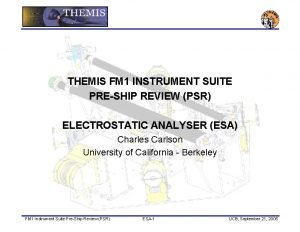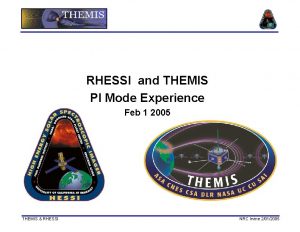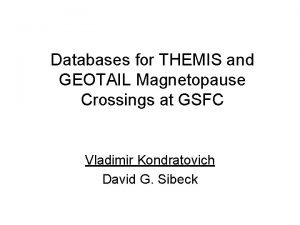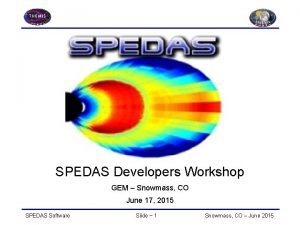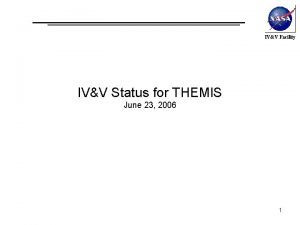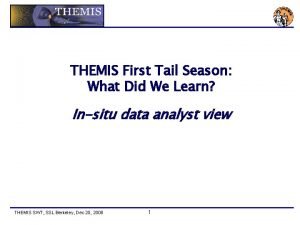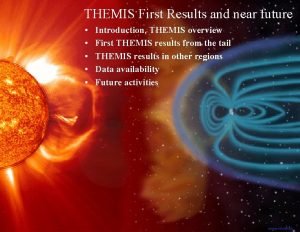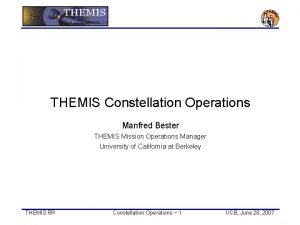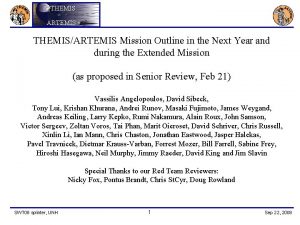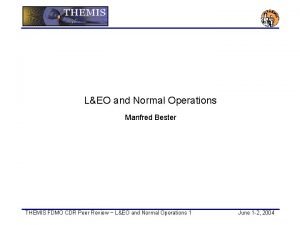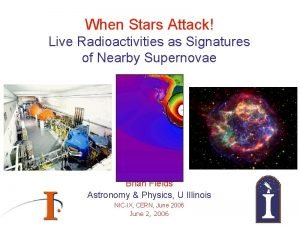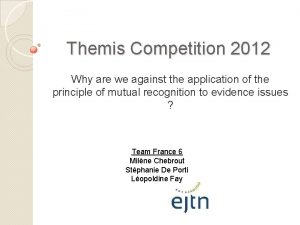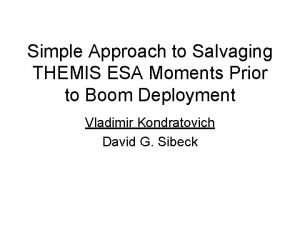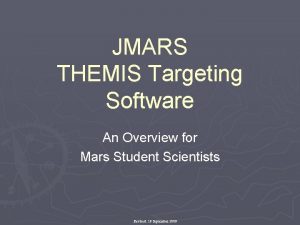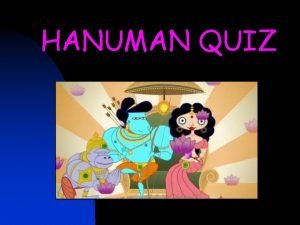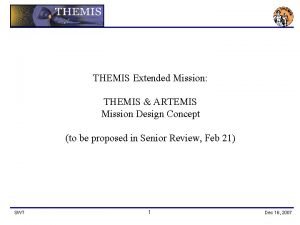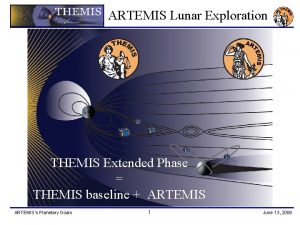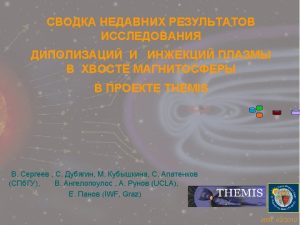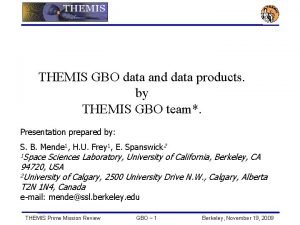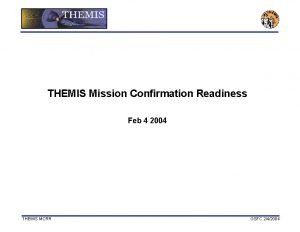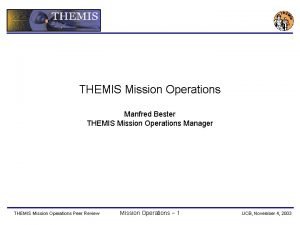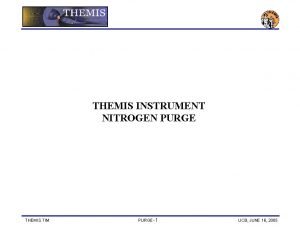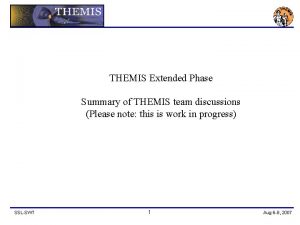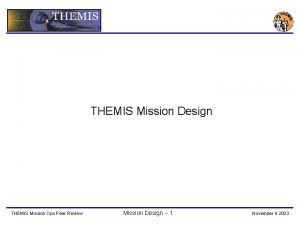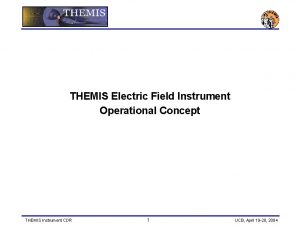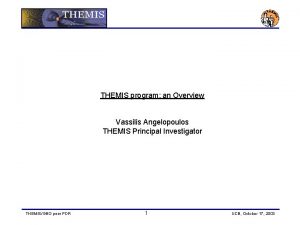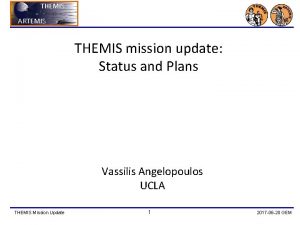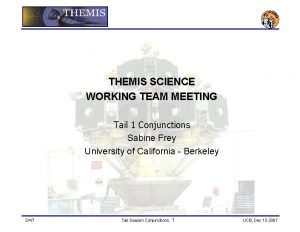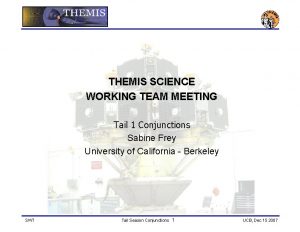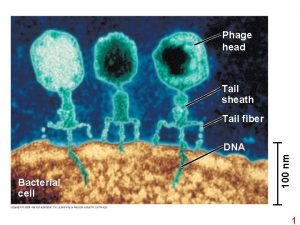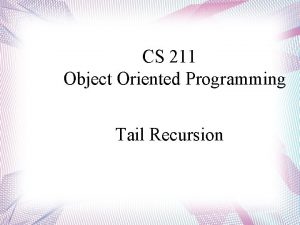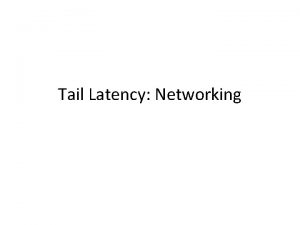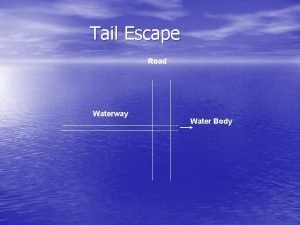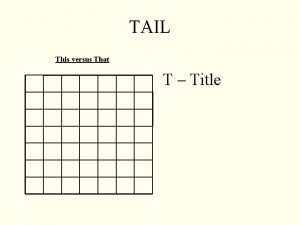THEMIS First Tail Season What Did We Learn






















- Slides: 22

THEMIS First Tail Season: What Did We Learn? In-situ data analyst view THEMIS SWT, SSL Berkeley, Dec 20, 2008 1

Ø THEMIS presentations on AGU 2008 FM: § New Perspectives on Substorms: § 10 of 14 oral presentations § 27 of 43 posters § Modes of Solar Wind Magnetosphere Energy Transfer: § 2 of 7 oral presentations § 7 of 31 posters Publications: http: //themis. ssl. berkeley. edu/publications. shtml THEMIS SWT, SSL Berkeley, Dec 20, 2008 2

Substorm event studies: Results and open questions Topics highlighted: § Timing and event sequence § Problem of t 0; § Inside-out or inside-in? Neither? § CD or MRX? Are they necessarily competetitve? § MI communication during substorms § Do we understand it? § Dipolarizations: Is there break of the frozen-in? § When and where is “frozen-in” violated? THEMIS SWT, SSL Berkeley, Dec 20, 2008 3

1 st tail season (Jan-Mar 2008) Feb-10 Feb-14 Feb-18 Feb-22 Feb-26 Mar-01 Jan-29 Feb-2 Feb-6 Midnight THEMIS SWT, SSL Berkeley, Dec 20, 2008 Pre-midnight 4

Substorm Timing: Problem of t 0 1 st. TRx 2 nd 1 st 3 rd 2 n TAI d 3 r TCD Similar approach: C. Gabrielse et al. , JGR, in press J. Liu et al. , Ann Geophys. , in press THEMIS SWT, SSL Berkeley, Dec 20, 2008 5 d

Substorm Timing: Problem of t 0 Alternative view: “Traditional” RX signatures -Bz, -Vx +Bz, +Vx THEMIS SWT, SSL Berkeley, Dec 20, 2008 6

Substorm Timing: Problem of t 0 § Although we have five spacecraft and the dense GBO network, timing is still sort of an art. § What are in-situ observable signatures of substrom/intensification onset in the plasma sheet? § The definition should be based on detectable signatures of a clear physical mechanism (M. Sitnov, AGUFM 08 presentation). THEMIS SWT, SSL Berkeley, Dec 20, 2008 7

Substorm Timing: MI Communication Angelopoulos et al. , Feb. 26, 2008: 96 s C. Gabrielse et al. , Feb. 16, 2008: 89 s J. Liu et al. , Feb. 22, 2008: 70 - 100 s. Runov et al. , March 1, 2008: 20 s ? !! (marginal) THEMIS SWT, SSL Berkeley, Dec 20, 2008 8

Substorm Timing: MI Communication Ø Communication time inferred from in-situ and ground-based measurements seems to be inconsistent with the Alfvenic interaction (~2 min). Ø What did we learn from AGU FM presentations: § MHD RX modeling shows that RX starts from slow Sweet-Parker regime and gradually evolves to fast regime (e. g. , G. Lapenta, AGUFM 2008); § The magnetotail plasma sheet becomes unstable BEFORE the reconnection starts (G. Siscoe, AGUFM 2008 poster, J. Raeder, AGUFM 2008, P. Zhu, AGUFM 2008 poster). § What are ionospheric signatures (if any) of this pre-reconnection plasma/current sheet activity? Can this causes initial auroral intensification? Ø MI communication via KAW (J. Drake’s comment, Bob Lysak’s presentation). What are observable signatures? THEMIS SWT, SSL Berkeley, Dec 20, 2008 9

Outside-in vs inside-out: Neither? 2 nd Inside out model 1 st 3 rd THEMIS Aurora Current Disruption Reconnection 2 n d 1 st Outside-In model 3 rd 2 nd THEMIS SWT, SSL Berkeley, Dec 20, 2008 1 st 10 3 r d

CD vs RX: Are they necessarily competitive? THEMIS SWT, SSL Berkeley, Dec 20, 2008 11

March 1, 2008 Summary of observations ASI 0148: 42 01: 54: 30 UT MAG (Pi 2) P 2 X=-17 RE 0148: 45 0154: 40 THEMIS SWT, SSL Berkeley, Dec 20, 2008 SST Twd flux 0148: 25 IVD 12

§ Processes of rapid plasma energization in the near-Earth plasma sheet (R~-8 RE) and in the mid-tail plasma sheet (R~-20) may act simultaneously and, likely, independently. § Similar conclusion: X Cao et al. (presented by J. Wang) AGUFM 08. § Global modeling of the 2008/03/01 event: M. El-Alaoui et al, AGUFM 08 poster, M. Ashour-Abdalla et al. , AGUFM 2008. § Similar model results: R. Winglee et al. , AGUFM 2008. THEMIS SWT, SSL Berkeley, Dec 20, 2008 13

Dipolarization – Is it MHD process? THEMIS SWT, SSL Berkeley, Dec 20, 2008 14

Dipolarization – Is it MHD process? § The answer is “YES” (J. Mc. Fadden, AGUFM 2008) § Always? Let’s see what the current tail season will show… § Dipolarizations: Patchy (“turbulent”, “granulated”) highly fluctuating field (V. Sergeev, AGUFM 08, Retino et al. , AGUFM 08). Ø What about plasma and total pressures? § How do plasma and total pressures behave during dipolarizations? § increase of Pp and Pt at R~-11 RE (V. Sergeev, AGUFM 2008, Y. Miyashita (Geotail statistics), AGUFM 2008 poster § Pp increases at R<11 RE downtail and strongly decreases beyond -16 RE after onset (X. Xing, AGUFM 2008 poster) THEMIS SWT, SSL Berkeley, Dec 20, 2008 15

Do we see violations of the “frozen-in” Yes, we do! During current sheet thinning. (J. Mc. Fadden et al. ) THEMIS SWT, SSL Berkeley, Dec 20, 2008 16

Ion Distribution Function During CS Thinning § Ion distribution functions observed by the THEMIS P 1 probe at the end of the growth phase of the Feb. 26 substorm ( Angelopoulos et al. , Science, 2008) and one calculated using the Sitnov et al. (2006) model. The dashed white line in indicates the boundary between gyrating and meandering particles (X. -Z. Zhou et al. AGUFM 08 poster) § The THEMIS P 3, P 4, and P 5 configuration during current tail season will allow us to estimate gradients directly (A. Albert et al. , Analysis of Three-spacecraft data Using Planar Reciprocal Vectors, AGUFM 08 poster) THEMIS SWT, SSL Berkeley, Dec 20, 2008 17

Non-substorm studies Ø Magnetotail plasma/current sheet flapping § L. Kepko et al. , AGUFM 2008 Poster § A. Runov et al. , AGUFM 2008 Poster THEMIS SWT, SSL Berkeley, Dec 20, 2008 18

4/5 THEMIS probes observed periodic kink structures. SMC interval. No correlation of kinks with substorm activity/phase (above). Activations temporarily disrupt kink (right figure) but kink continues to propagate (see esp. 0900) Aurora show large loop structure, bright spots circle around loop. Probes map to Harang discontinuity (generally). L. Kepko et al. , AGUFM 2008 poster THEMIS SWT, SSL Berkeley, Dec 20, 2008 19

Back–up slides THEMIS SWT, SSL Berkeley, Dec 20, 2008 20

Space twister, A. Keiling et al. THEMIS SWT, SSL Berkeley, Dec 20, 2008 21

Substorm Timing: Problem of t 0 THEMIS SWT, SSL Berkeley, Dec 20, 2008 22
 Kinesthetic learner
Kinesthetic learner George washington carver center for arts and technology
George washington carver center for arts and technology Katrina connors
Katrina connors Preship
Preship Themis pi
Themis pi Themis lenguaje inclusivo
Themis lenguaje inclusivo Themis athanassiadou
Themis athanassiadou Themis
Themis Themis dc
Themis dc Themis plugin
Themis plugin Themis
Themis Themis
Themis Themis
Themis Themis constellation
Themis constellation Themis
Themis Themis
Themis Themis athanassiadou
Themis athanassiadou Themis competition
Themis competition Esa themis
Esa themis Themis software
Themis software How did you carry out extension work activities
How did you carry out extension work activities Hanuman quiz
Hanuman quiz Did you learn
Did you learn



